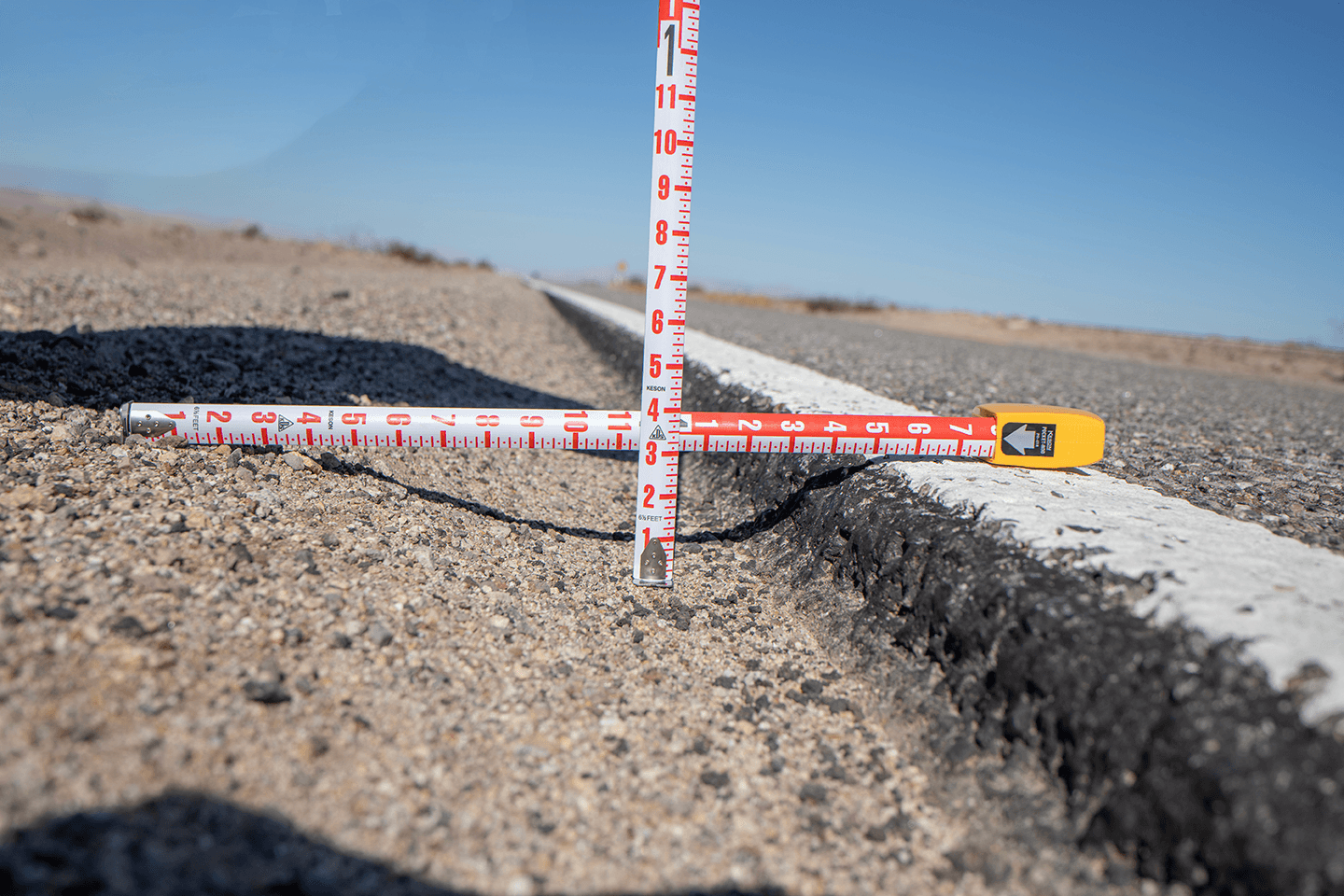
Navigating the Edge: Understanding Pavement Edge Drop-Offs
Navigating the Edge: Understanding Pavement Edge Drop-Offs
Colin Wein, P.E.
Colin Wein, P.E.



What is a Pavement Edge Drop-Off?
A pavement edge drop-off occurs when a vehicle unintentionally leaves the travel lane and the tires drop down onto a lower surface. This discontinuity in the road surface can occur when a roadway is resurfaced without restoring the adjacent shoulder or if there’s a lack of constructed shoulder at the edge of the paved road and instead, there is a drop-off to a grassy or gravel surface. If the edge drop is high enough, it can create a problem for drivers who attempt to steer over it.
A Brief History of Pavement Edge Drop-Off Safety Awareness
Pavement-edge drop-offs have been recognized as a potential highway safety problem since 1954 when the American Association of State Highway Officials’ (AASHO) 1954 publication A Policy on Geometric Design of Rural Highways, stated the following: “Unstabilized shoulders frequently are hazardous because the elevation of the shoulder at the pavement edge may be several inches lower than the pavement.” According to the U.S. Department of Transportation Federal Highway Administration, an estimated 11,000 Americans suffer injuries and 160 die each year in crashes related to unsafe pavement edges.
Why Edge Drop-Offs Are Dangerous for Drivers
When a vehicle leaves the travel lane, the research indicates the normal reaction of a driver is to quickly attempt to return the vehicle back to the travel lane. If there is a vertical discontinuity, or edge drop-off, between the travel lane and the lower surface, it can be very difficult to return the vehicle back to the travel lane safely. A driver’s ability to recover from an edge drop-off depends on the height and shape of the drop, the vehicle’s speed and angle and the width of the travel lane in which they are trying to recover to. The probability of a successful recovery decreases as the edge drop-off approaches 90 degrees, the edge drop-off increases, the vehicle speed increases and the recovery lane width decreases.
Possible Crash Scenarios Involving Pavement Edge Drop-Offs
The most common safety hazard is when the right-side tires contact and begin “scrubbing” against the vertical face of the drop-off which prevents the tire from climbing back up to the travel lane. The phenomenon of control loss after the occurrence of edge scrubbing is described by Zimmer and Ivey (1983) as follows:
· A vehicle is under control in a traffic lane adjacent to a pavement edge where an unpaved shoulder is lower than the pavement.
· Because of inattention, distraction, or some other reason the vehicle is allowed to move so that the right wheels are on the unpaved shoulder and just off the paved surface. The driver then carefully tries to steer the vehicle gently to bring the right wheels gradually back up onto the paved surface without reducing speed significantly.
· The right front wheel encounters the pavement edge at an extremely flat angle and is prevented from moving back onto the pavement. The driver further increases the steering angle to make the vehicle regain the pavement. However, the vehicle continues to scrub the pavement edge and does not respond. At this time there is equilibrium between the cornering force to the left and the edge force acting to the right.
· The driver continues to increase the steering input until the critical steering angle is reached and the right front wheel finally mounts the paved surface. Suddenly, in less than one wheel revolution, the pavement edge force has disappeared and the cornering force of the right front wheel may have doubled because of increases in the available friction on the pavement and the increase in the right front wheel load caused by cornering.
· The vehicle yaws radically to the left, pivoting about the right rear tire, until that wheel can be dragged up onto the pavement surface. The excessive left turn and yaw continues, and it is too rapid in its development for the driver to prevent penetration into the oncoming traffic lane.
· A collision with oncoming vehicles or spin-out and possible vehicle roll may then occur.
In addition to the crash described above, Glennon and Hill (2004) suggest several other possible outcomes when a driver leaves the roadway and encounters an edge drop-off.
· The first five outcomes result when a driver leaves the roadway and traverses a drop-off under a low to moderate departure angle. The driver may slow to an appropriate speed while traveling parallel to the travel lane and then safely return to the road (Outcome 1). If the driver returns to the roadway at a shallow return angle, the tires tend to scrub. When this happens, the vehicle may rebound out of control, possibly resulting in a collision or rollover without returning to the travel lane (Outcome 2). If the driver re-enters the travel lane, he or she may either return safely (Outcome 3) or, if the driver steers too severely, the vehicle may cross into an adjacent lane or encroach on the far side of the roadway (Outcomes 4 and 5). Either situation may result in rollover or collision. If the driver re-enters the lane at a moderate return angle, he or she may return safely to the travel lane without tire scrubbing (Outcome 3). If the driver steers too severely, however, the vehicle may either cross into adjacent travel lanes, or the far side of the roadway, or may skid out of control, which may again result in a collision or rollover (Outcomes 4 and 5). If the driver steers back onto the travel surface at a high return angle, the vehicle is also likely to skid on the shoulder with the potential for collision or rollover (Outcome 6). The last outcome is that the vehicle leaves the roadway at a high departure angle so that recovery is unlikely. As the vehicle encroaches on the roadside, collision or rollover may result (Outcome 7).
Safety Standards for Edge Drop-Off Heights and Designs
According to the U.S. Department of Transportation Federal Highway Administration, edge drop-offs of three or more inches are unsafe if the roadway edge is at a 90-degree angle to the shoulder surface. Olson et al. concluded that a drop-off magnitude of 4.5 inches cannot be safely negotiated at speeds as low as 20 mph. A drop-off magnitude of 3.0 inches could be generally safely negotiated at speeds of 30 mph, but only in the largest of the three test vehicles used with poor performance in the two small vehicles. Humphreys, et al. concluded that drop-offs of four or more inches are unsafe if the roadway edge is at a 90-degree angle to the shoulder surface. Olson et al. also concluded that rounded or beveled pavement edges greatly reduced the hazard and recommended using a 45-degree bevel edge in which subjects consistently negotiated it successfully at speeds up to 55 mph, the highest tested. Humphreys, et al. concluded that using a 45-degree-angle fillet of asphalt provides a surface that vehicles could use to climb back onto a roadway with no loss of control.
What is a Pavement Edge Drop-Off?
A pavement edge drop-off occurs when a vehicle unintentionally leaves the travel lane and the tires drop down onto a lower surface. This discontinuity in the road surface can occur when a roadway is resurfaced without restoring the adjacent shoulder or if there’s a lack of constructed shoulder at the edge of the paved road and instead, there is a drop-off to a grassy or gravel surface. If the edge drop is high enough, it can create a problem for drivers who attempt to steer over it.
A Brief History of Pavement Edge Drop-Off Safety Awareness
Pavement-edge drop-offs have been recognized as a potential highway safety problem since 1954 when the American Association of State Highway Officials’ (AASHO) 1954 publication A Policy on Geometric Design of Rural Highways, stated the following: “Unstabilized shoulders frequently are hazardous because the elevation of the shoulder at the pavement edge may be several inches lower than the pavement.” According to the U.S. Department of Transportation Federal Highway Administration, an estimated 11,000 Americans suffer injuries and 160 die each year in crashes related to unsafe pavement edges.
Why Edge Drop-Offs Are Dangerous for Drivers
When a vehicle leaves the travel lane, the research indicates the normal reaction of a driver is to quickly attempt to return the vehicle back to the travel lane. If there is a vertical discontinuity, or edge drop-off, between the travel lane and the lower surface, it can be very difficult to return the vehicle back to the travel lane safely. A driver’s ability to recover from an edge drop-off depends on the height and shape of the drop, the vehicle’s speed and angle and the width of the travel lane in which they are trying to recover to. The probability of a successful recovery decreases as the edge drop-off approaches 90 degrees, the edge drop-off increases, the vehicle speed increases and the recovery lane width decreases.
Possible Crash Scenarios Involving Pavement Edge Drop-Offs
The most common safety hazard is when the right-side tires contact and begin “scrubbing” against the vertical face of the drop-off which prevents the tire from climbing back up to the travel lane. The phenomenon of control loss after the occurrence of edge scrubbing is described by Zimmer and Ivey (1983) as follows:
· A vehicle is under control in a traffic lane adjacent to a pavement edge where an unpaved shoulder is lower than the pavement.
· Because of inattention, distraction, or some other reason the vehicle is allowed to move so that the right wheels are on the unpaved shoulder and just off the paved surface. The driver then carefully tries to steer the vehicle gently to bring the right wheels gradually back up onto the paved surface without reducing speed significantly.
· The right front wheel encounters the pavement edge at an extremely flat angle and is prevented from moving back onto the pavement. The driver further increases the steering angle to make the vehicle regain the pavement. However, the vehicle continues to scrub the pavement edge and does not respond. At this time there is equilibrium between the cornering force to the left and the edge force acting to the right.
· The driver continues to increase the steering input until the critical steering angle is reached and the right front wheel finally mounts the paved surface. Suddenly, in less than one wheel revolution, the pavement edge force has disappeared and the cornering force of the right front wheel may have doubled because of increases in the available friction on the pavement and the increase in the right front wheel load caused by cornering.
· The vehicle yaws radically to the left, pivoting about the right rear tire, until that wheel can be dragged up onto the pavement surface. The excessive left turn and yaw continues, and it is too rapid in its development for the driver to prevent penetration into the oncoming traffic lane.
· A collision with oncoming vehicles or spin-out and possible vehicle roll may then occur.
In addition to the crash described above, Glennon and Hill (2004) suggest several other possible outcomes when a driver leaves the roadway and encounters an edge drop-off.
· The first five outcomes result when a driver leaves the roadway and traverses a drop-off under a low to moderate departure angle. The driver may slow to an appropriate speed while traveling parallel to the travel lane and then safely return to the road (Outcome 1). If the driver returns to the roadway at a shallow return angle, the tires tend to scrub. When this happens, the vehicle may rebound out of control, possibly resulting in a collision or rollover without returning to the travel lane (Outcome 2). If the driver re-enters the travel lane, he or she may either return safely (Outcome 3) or, if the driver steers too severely, the vehicle may cross into an adjacent lane or encroach on the far side of the roadway (Outcomes 4 and 5). Either situation may result in rollover or collision. If the driver re-enters the lane at a moderate return angle, he or she may return safely to the travel lane without tire scrubbing (Outcome 3). If the driver steers too severely, however, the vehicle may either cross into adjacent travel lanes, or the far side of the roadway, or may skid out of control, which may again result in a collision or rollover (Outcomes 4 and 5). If the driver steers back onto the travel surface at a high return angle, the vehicle is also likely to skid on the shoulder with the potential for collision or rollover (Outcome 6). The last outcome is that the vehicle leaves the roadway at a high departure angle so that recovery is unlikely. As the vehicle encroaches on the roadside, collision or rollover may result (Outcome 7).
Safety Standards for Edge Drop-Off Heights and Designs
According to the U.S. Department of Transportation Federal Highway Administration, edge drop-offs of three or more inches are unsafe if the roadway edge is at a 90-degree angle to the shoulder surface. Olson et al. concluded that a drop-off magnitude of 4.5 inches cannot be safely negotiated at speeds as low as 20 mph. A drop-off magnitude of 3.0 inches could be generally safely negotiated at speeds of 30 mph, but only in the largest of the three test vehicles used with poor performance in the two small vehicles. Humphreys, et al. concluded that drop-offs of four or more inches are unsafe if the roadway edge is at a 90-degree angle to the shoulder surface. Olson et al. also concluded that rounded or beveled pavement edges greatly reduced the hazard and recommended using a 45-degree bevel edge in which subjects consistently negotiated it successfully at speeds up to 55 mph, the highest tested. Humphreys, et al. concluded that using a 45-degree-angle fillet of asphalt provides a surface that vehicles could use to climb back onto a roadway with no loss of control.
References
P.L. Olson, R. A. Zimmer and V. Pezoldt, “Pavement Edge Drop,” Transportation Research Board, 1986.
R.A. Zimmer and D.L. Ivey. Pavement Edges and Vehicle Stability: A Basis for Maintenance Guidelines. In Transportation Research Record 946, TRB, National Research Council, Washington, D.C., 1983
D. L. Ivey et al., "Safety in Construction Zones Where Pavement Edges and Drop Offs Exist," Transportation Research Record 1163, 1988.
American Association of State Highway Officials, "A Policy on Geometric Design of Rural Highways," 1954.
John C. Glennon, "Effect of Pavement/Shoulder Drop-Offs on Highway Safety: A Synthesis of Prior Research," Transportation Research Board,1985.
Glennon, J. C., and P. F. Hill. 2004. Roadway safety and tort liability. 2nd Ed. Tucson, AZ: Lawyers and Judges Publishing Company, Inc.
J. B. Humphreys and J. A. Parham, "The Elimination or Mitigation of Hazards Associated with Pavement Edge Drop-Offs During Roadway Resurfacing," AAA Foundation for Traffic Safety, 1994.
The Safety Edge: Preventing Crashes Caused by Unsafe Pavement Edge Drop-offs, U.S. Department of Transportation Federal Highway Administration, FHWA Publication No: FHWA-RC-BAL-04-0015
References
P.L. Olson, R. A. Zimmer and V. Pezoldt, “Pavement Edge Drop,” Transportation Research Board, 1986.
R.A. Zimmer and D.L. Ivey. Pavement Edges and Vehicle Stability: A Basis for Maintenance Guidelines. In Transportation Research Record 946, TRB, National Research Council, Washington, D.C., 1983
D. L. Ivey et al., "Safety in Construction Zones Where Pavement Edges and Drop Offs Exist," Transportation Research Record 1163, 1988.
American Association of State Highway Officials, "A Policy on Geometric Design of Rural Highways," 1954.
John C. Glennon, "Effect of Pavement/Shoulder Drop-Offs on Highway Safety: A Synthesis of Prior Research," Transportation Research Board,1985.
Glennon, J. C., and P. F. Hill. 2004. Roadway safety and tort liability. 2nd Ed. Tucson, AZ: Lawyers and Judges Publishing Company, Inc.
J. B. Humphreys and J. A. Parham, "The Elimination or Mitigation of Hazards Associated with Pavement Edge Drop-Offs During Roadway Resurfacing," AAA Foundation for Traffic Safety, 1994.
The Safety Edge: Preventing Crashes Caused by Unsafe Pavement Edge Drop-offs, U.S. Department of Transportation Federal Highway Administration, FHWA Publication No: FHWA-RC-BAL-04-0015

LET’S WORK TOGETHER
We’re looking forward to hearing how we can help.
Call our office at 720-458-9190 or click below.
TELL US ABOUT YOUR CASE


LET’S WORK TOGETHER
We’re looking forward to hearing how we can help.
Call our office at 720-458-9190 or click below.
TELL US ABOUT YOUR CASE


LET’S WORK TOGETHER
We’re looking forward to hearing how we can help.
Call our office at 720-458-9190 or click below.
TELL US ABOUT YOUR CASE
Corporate Headquarters
Compass Consulting Engineers PC
10875 Dover St., # 900 Westminster, CO 80021
Pacific Northwest Region
Compass Consulting Engineers PC
13036 SE Kent-Kangley Rd, Suite 7, Kent, WA 98030
Canadian Region
Compass Consulting Engineers Inc.
1975 McCallum Road, Unit 115 #1029, Abbotsford, BC V2S 3N3
Corporate Headquarters
Compass Consulting Engineers PC
10875 Dover St., # 900 Westminster, CO 80021
Pacific Northwest Region
Compass Consulting Engineers PC
13036 SE Kent-Kangley Rd, Suite 7, Kent, WA 98030
Canadian Region
Compass Consulting Engineers Inc.
1975 McCallum Road, Unit 115 #1029, Abbotsford, BC V2S 3N3
Corporate Headquarters
Compass Consulting Engineers PC
10875 Dover St., # 900 Westminster, CO 80021
Pacific Northwest Region
Compass Consulting Engineers PC
13036 SE Kent-Kangley Rd, Suite 7, Kent, WA 98030
Canadian Region
Compass Consulting Engineers Inc.
1975 McCallum Road, Unit 115 #1029, Abbotsford, BC V2S 3N3